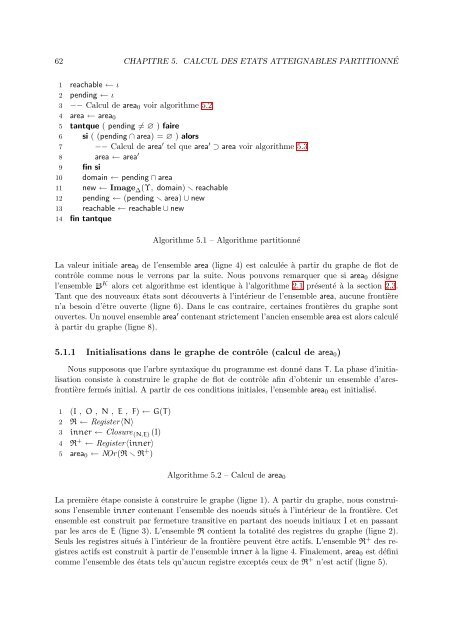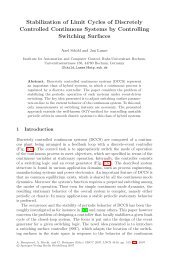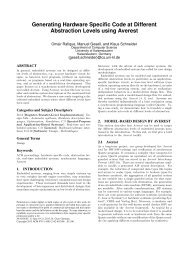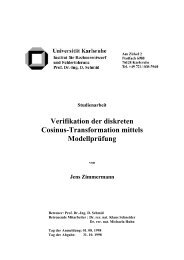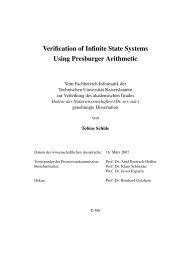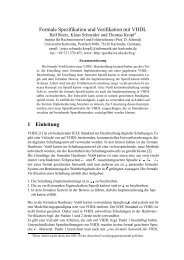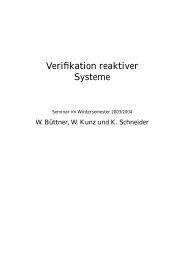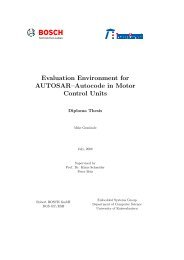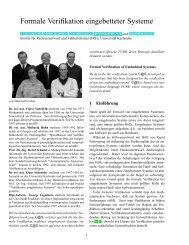Calcul des etats atteignables de programmes Esterel partitionne ...
Calcul des etats atteignables de programmes Esterel partitionne ...
Calcul des etats atteignables de programmes Esterel partitionne ...
- No tags were found...
Create successful ePaper yourself
Turn your PDF publications into a flip-book with our unique Google optimized e-Paper software.
62 CHAPITRE 5. CALCUL DES ETATS ATTEIGNABLES PARTITIONNÉ1 reachable ← ι2 pending ← ι3 −− <strong>Calcul</strong> <strong>de</strong> area 0 voir algorithme 5.24 area ← area 05 tantque ( pending ≠ ∅ ) faire6 si ( (pending ∩ area) = ∅ ) alors7 −− <strong>Calcul</strong> <strong>de</strong> area ′ tel que area ′ ⊃ area voir algorithme 5.38 area ← area ′9 fin si10 domain ← pending ∩ area11 new ← Image ∆ (Υ, domain) reachable12 pending ← (pending area) ∪ new13 reachable ← reachable ∪ new14 fin tantqueAlgorithme 5.1 – Algorithme partitionnéLa valeur initiale area 0 <strong>de</strong> l’ensemble area (ligne 4) est calculée à partir du graphe <strong>de</strong> flot <strong>de</strong>contrôle comme nous le verrons par la suite. Nous pouvons remarquer que si area 0 désignel’ensemble B K alors cet algorithme est i<strong>de</strong>ntique à l’algorithme 2.1 présenté à la section 2.3.Tant que <strong><strong>de</strong>s</strong> nouveaux états sont découverts à l’intérieur <strong>de</strong> l’ensemble area, aucune frontièren’a besoin d’être ouverte (ligne 6). Dans le cas contraire, certaines frontières du graphe sontouvertes. Un nouvel ensemble area ′ contenant strictement l’ancien ensemble area est alors calculéà partir du graphe (ligne 8).5.1.1 Initialisations dans le graphe <strong>de</strong> contrôle (calcul <strong>de</strong> area 0 )Nous supposons que l’arbre syntaxique du programme est donné dans T. La phase d’initialisationconsiste à construire le graphe <strong>de</strong> flot <strong>de</strong> contrôle afin d’obtenir un ensemble d’arcsfrontièrefermés initial. A partir <strong>de</strong> ces conditions initiales, l’ensemble area 0 est initialisé.1 (I , O , N , E , F) ← G(T)2 R ← Register〈N〉3 inner ← Closure (N,E) (I)4 R + ← Register〈inner〉5 area 0 ← NOr(R R + )Algorithme 5.2 – <strong>Calcul</strong> <strong>de</strong> area 0La première étape consiste à construire le graphe (ligne 1). A partir du graphe, nous construisonsl’ensemble inner contenant l’ensemble <strong><strong>de</strong>s</strong> noeuds situés à l’intérieur <strong>de</strong> la frontière. Cetensemble est construit par fermeture transitive en partant <strong><strong>de</strong>s</strong> noeuds initiaux I et en passantpar les arcs <strong>de</strong> E (ligne 3). L’ensemble R contient la totalité <strong><strong>de</strong>s</strong> registres du graphe (ligne 2).Seuls les registres situés à l’intérieur <strong>de</strong> la frontière peuvent être actifs. L’ensemble R + <strong><strong>de</strong>s</strong> registresactifs est construit à partir <strong>de</strong> l’ensemble inner à la ligne 4. Finalement, area 0 est définicomme l’ensemble <strong><strong>de</strong>s</strong> états tels qu’aucun registre exceptés ceux <strong>de</strong> R + n’est actif (ligne 5).


